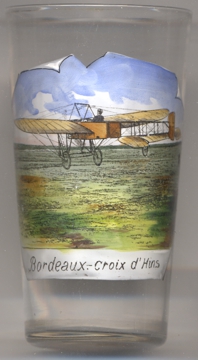

|
| FRANCE | FRANCE |
| région: Nouvelle-Aquitaine | |
| département: 33, Gironde |
 Croix d'Hins is situated at an elevation of 58 m about about 4 km northeast of Marcheprime and about
24 km southwest of Bordeaux in the arrondissement Arcachon, département Gironde in the région
Nouvelle-Aquitaine of southwestern France. Croix d'Hins is part of the municipality of Marcheprime, which has a total population of
about 4,900 (2018).
Croix d'Hins is situated at an elevation of 58 m about about 4 km northeast of Marcheprime and about
24 km southwest of Bordeaux in the arrondissement Arcachon, département Gironde in the région
Nouvelle-Aquitaine of southwestern France. Croix d'Hins is part of the municipality of Marcheprime, which has a total population of
about 4,900 (2018).
Already in 1909, the company of aeronautics pioneers Louis Blé:riot and the Voisin brothers (Gabriel and Charles)) established an aerodrome here in order to test the Blériot airplanes. The inauguration was originally planed for 1 December 1909, but had to be postponed due to bad weather. The airfield of Croix d'Hins today is best-known for the fatal accident of the aviator and sculptor Léon Delagrange who died here at the age of only 37 when the wings of his Blériot XI broke during a training flight. Thereafter, there was practically no more activity on this ground except in 1910 when the first air meeting of Gironde took place, and in 1914 when the aerodrome was part of the stopovers of the first air rally of Monaco. On February 1 and 2, 1911, Georges Bellenger carried out a long-distance air mission and linked Vincennes-Maison-Blanche to Croix d'Hins, at the controls of a Blériot, in a 7 h 15 min flight. The aerodrome was abandoned in 1918–1920 in favor of the Mérignac aerodrome, giving way to the Radio Bordeaux Lafayette station. A gunpowder factory was created at the edge of the former airfield in 1913. During World War I, a shooting range was added, which however was in use only between 1916 and 1917.
The picture on glass no. 4126 show a  Blériot monoplane, possibly a Blériot XI, the most
successful of Blériot's models. It is famous for having made the first crossing of the English Channel on 25 July 1909, with its inventor
as the pilot. Blériot covered the distance of 38 km in 37 minutes at an average speed of 61.6 km/h. Its monoplane configuration,
front engine and rear stabilizer, very different from the canard biplane configuration with rear propellers of the planes of Orville and Wilbur Wright,
eventually became the most common. Blériot thought it would be his last plane, because he was ruined by his inventions. The Blériot XI
was one of the first mass-produced planes, sold in hundreds of copies, in four categories: training, tourism, competition and military.
The glass is labeled as a souvenir from Bordeaux-Croix d'Hins.
Blériot monoplane, possibly a Blériot XI, the most
successful of Blériot's models. It is famous for having made the first crossing of the English Channel on 25 July 1909, with its inventor
as the pilot. Blériot covered the distance of 38 km in 37 minutes at an average speed of 61.6 km/h. Its monoplane configuration,
front engine and rear stabilizer, very different from the canard biplane configuration with rear propellers of the planes of Orville and Wilbur Wright,
eventually became the most common. Blériot thought it would be his last plane, because he was ruined by his inventions. The Blériot XI
was one of the first mass-produced planes, sold in hundreds of copies, in four categories: training, tourism, competition and military.
The glass is labeled as a souvenir from Bordeaux-Croix d'Hins.
[http://www.fallingrain.com/world/FR/97/Croix_dHins.html;
http://www.fallingrain.com/world/FR/97/Croix_dHins.htmlhttps://fr.wikipedia.org/wiki/Marcheprime#Croix_d'Hins,
https://fr.wikipedia.org/wiki/Louis_Bl%C3%A9riot, https://fr.wikipedia.org/wiki/Gabriel_Voisin, https://fr.wikipedia.org/wiki/L%C3%A9on_Delagrange;
https://fr.wikipedia.org/wiki/Bl%C3%A9riot_XI]
![[scale]](lineal.jpg)